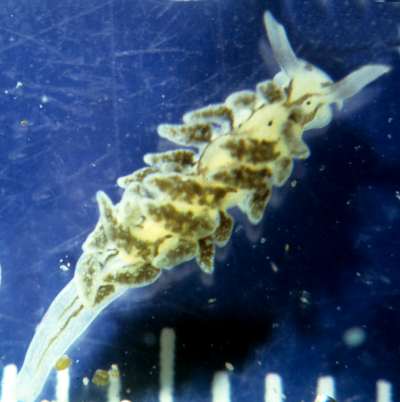
Hermaea vancouverensis
O'Donoghue, 1924
Order: SACOGLOSSA
Superfamily: LIMAPONTIOIDEA
Family: Hermaeidae
DISTRIBUTION
Upper: Hermaea vancouverensis found on Neorhodomela larix. Middle: red alga Neorhodomela larix. Lower: chain forming diatom Isthmia nervosa which lives attached to Neorhodomela - note mm scale in upper part of photo. Oregon, USA, NE Pacific Ocean, mid-1980s. Photographer: Cynthia Trowbridge.
PHOTO
Northeast Pacific - Alaska to California (Trowbridge, 2002)
Northwest Pacific - South Kuril Islands, Russia (Chernyshev - in Forum)
The elongate body is translucent clear with a pattern of green to brown lines and spots cause by the colour of the digestive gland ducts and tubules. The cerata are arranged in a row down each side of the body, but as they are frequently detached, it is difficult to find a specimen with a full complement. The rhinophores are enrolled and auriform. The digestive gland as a duct running along each side of the body which gives off a single branch to each ceras. Anteriorly, in front of the pericardial swelling, there is a U or V shaped
green or dark coloured mark which is a branch of the digestive gland extending out inot each rhinophore. At the anterior base of each rhinophore there is a similar coloured patch and a line running up the anterior (or ventral) side of the rhinophore. Posteriorly, the digestive gland ducts extend down the foot beyond the last cerata. O'Donoghue records animals reaching about 5.5 mm in length.
It has been reported from the base of diatom covered Zostera leaves (O'Donoghue) and from the red algae Neorhodomela larix, where it eats the attached, chain-forming diatom Isthmia nervosa [see Trowbridge (2002) and Chernyshev (#14612)].
Note: Chernyshev [#14612 ] initially identified this species as S. akkeshiensis Baba, 1935, but agrees with Trowbridge's suggestion that Russian animals are identical with Hermaea vancouverensis [message #15995] . What is not clear is whether true Stiliger akkeshiensis Baba, 1935 is the same species.
-
O'Donoghue, C.H. 1924. Notes on the nudibranchiate Mollusca from the Vancouver Island region. IV. Additional species and records. Transactions of the Royal Canadian Institute 15: 1-33.
-
Trowbridge, C.D. 2002. Northeastern Pacific sacoglossan opisthobranchs: natural history review, bibliography, and prospectus. The Veliger 45:1-24.
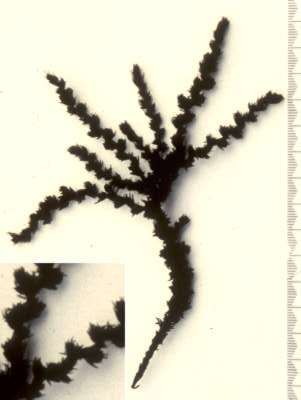
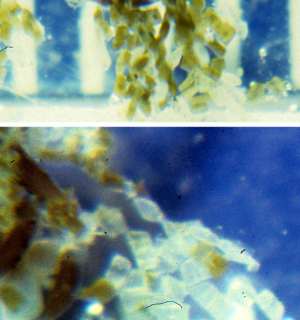
Rudman, W.B., 2006 (March 2) Hermaea vancouverensis O'Donoghue, 1924. [In] Sea Slug Forum. Australian Museum, Sydney. Available from http://www.seaslugforum.net/find/hermvanc
Related messages
Re: Identity of Stiliger akkeshiensis from Kuril Is
April 20, 2006
From: Alexei Chernyshev
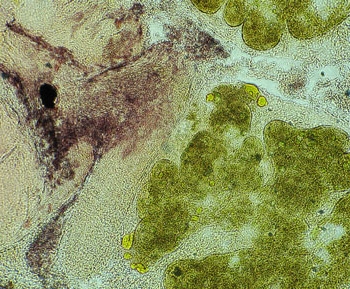
Concerning message #15995:
Dear Cynthia, Bill,
Here is a 'squash' of an animal of "Stiliger akkeshiensis" f rom the Kuril Islands showing the green pigments in the digestive gland and the purple brown pigment on the head.
Locality: Kuril Islands, 2-3 m, Russia, Pacific, 17 July, 2005, on the red algae. Length: 3-4 mm. Photographer: Alexei Chernyshev.
Sincerely yours,
Alexei
tsher@bio.dvgu.ru
Chernyshev, A.V., 2006 (Apr 20) Re: Identity of Stiliger akkeshiensis from Kuril Is. [Message in] Sea Slug Forum. Australian Museum, Sydney. Available from http://www.seaslugforum.net/find/16376Dear Alexei,
I thought it was appropriate to post this with Cynthia's messages on Hermaea and make this a sacoglossan day on the Forum.
Thanks for this photo very clearly shows the green of the chloroplasts.
Best wishes,
Bill Rudman
Identity of Stiliger akkeshiensis from Kuril Islands
March 3, 2006
From: Cynthia Trowbridge
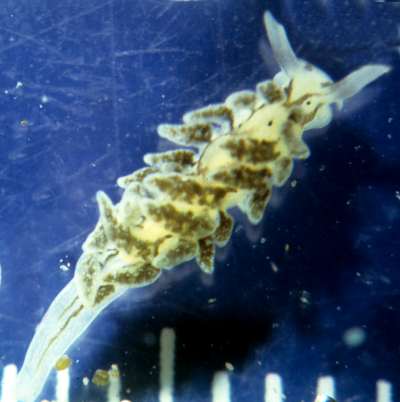
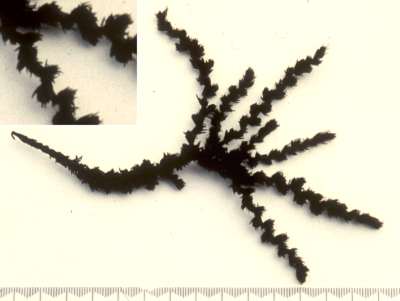
Concerning message #14724:
Dear Bill, Kathe, and Alexi,
Alexi and I had a private e-mail discussion about Stiliger akkeshiensis vs. Hermaea vancouverensis last year. As part of work on Japanese sacoglossans, I was trying to find and verify records of S. akkeshiensis Baba, 1935, and he mentioned that his sacoglossan species was found on the red alga Neorhodomela larix. On Oregon shores, we have Hermaea vancouverensis on Neorhodomela (see photo), eating the attached, chain-forming diatoms. When the discussion proceeded onto the Forum [messages #14724, #14728], I was working overseas and not in e-mail contact. Since that time, Alexi and I have agreed his species is Hermaea vancouverensis and that his records in the NW Pacific represent an intriguing and significant range extension for this Pacific species.
Excerpt of letter from Cynthia to Alexi, 22 Feb 2005:
"as a graduate student, I worked for my professor on Neorhodomela larix, its chemical ecology, palatability to molluscan and crustacean grazers. We have a small sacoglossan - Hermaea vancouverensis -- that feeds on the diatom (Isthmia nervosa) that is very frequent on Neorhodomela at the end of summer. I have attached a photo of that species to be sure we are not talking about that species. It has distinctive markings on head and back. This species is the most abundant and yet the least studied of our local sacoglossans."
I am glad to see that Kathe [#14724] thought the species was Hermaea vancouverensis because the radular teeth, external appearance, and ecology are identical to O'Donoghue's 1924 description. Please see my attached photo from Oregon from the mid-1980s. The diatom in the photo is the food Isthmia. All the NE Pacific details about this species are summarized in my 2002 review paper.
PHOTOS: Middle: red alga Neorhodomela larix. Lower: chain forming diatom Isthmia nervosa which lives attached to Neorhodomela - note mm scale in upper part of photo. Oregon, USA, NE Pacific Ocean, mid-1980s. Photographer: Cynthia Trowbridge.
We still do not know (1) whether Stiliger akkeshiensis and Hermaea vancouverensis are synonyms or (2) whether there is a "real" S. akkeshiensis in Hokkaido. The Hiranos and I plan on visiting the type locality in the next year so we hope to resolve this issue. Thank you for letting me clarify the situation.
-
O'Donoghue, C.H. 1924. Notes on the nudibranchiate Mollusca from the Vancouver Island region. IV. Additional species and records. Transactions of the Royal Canadian Institute 15: 1-33.
-
Trowbridge, C.D. 2002. Northeastern Pacific sacoglossan opisthobranchs: natural history review, bibliography, and prospectus. The Veliger 45:1-24.
Best wishes,
Cynthia
trowbric@onid.orst.edu
Trowbridge, C.D., 2006 (Mar 3) Identity of Stiliger akkeshiensis from Kuril Islands. [Message in] Sea Slug Forum. Australian Museum, Sydney. Available from http://www.seaslugforum.net/find/15995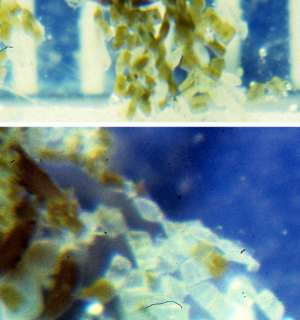
Dear Cynthia,
Thanks very much for clarifying this animal. If the Oregon and Russian animals were both on the red alga Neorhodomela larix, does that mean the chain forming diatom (Isthmia nervosa) on which they actually feed always asociated with the red algae? I had assumed the red coloured digestive gand in Alexi's animals were from red pigment in the red algae. If they in fact feed on green diatoms do you have any idea where the red pigment comes from? If its not from red algae it makes me wonder whether some of the other 'red' sacoglossans are also not red algae feeders to.
Best wishes,
Bill Rudman
Re: Stiliger akkeshiensis from Kuril Islands
September 9, 2005
From: Bill Rudman
Note added 2 March 2006: Russian animals are now considered to be Hermaea vancouverensis [see message #15995].
Concerning message #14612:
I have prepared a Fact Sheet for Stiliger akkeshiensis, based on Alexei's photos. This species was described from Akkeshi Bay, Hokkaido, on the basis of a 6 preserved specimens, about 4mm long preserved. All we know about its colour is the sentence "preserved specimens have traces of blackish mottles and streaks on the head, rhinophores, back, tail and sides.." The illustration of the radula in Baba's description is very similar to the one illustrated here.
If Alexei Chernyshev's description is correct then we can add considerably to the original description. The body has a translucent yellowish tinge and there is a large purplish patch on each side of the head in front of the rhinophores. There is a purplish line running from the patch back to the rhinophores and a ring of the same colour around the rhinophore stalk. A dark line runs back from each rhinophores, on the inside of the eye, to meet its counterpart from the other side in the dorsal midline just in front of the first cerata. It is possible that these lines are a branch of the digestive gland duct, because a very similar looking dark line runs back on eacg side linking the bases of all the cerata. There are a few blackish purple marks on the dorsum, between the single row of cerata, and in one animal there is a distinct median line behind the most posterior cerata. Dark purplish lobules of the digestive gland can be seen through the transparent ceratal wall.
Baba considered this species to belong the subgenus Ercolania.
-
Baba, K. (1935) The fauna of Akkeshi Bay. 1. Opisthobranchia. Journal Faculty Science, Hokkaido Imperial University, series 6, Zoology 4: 115-125. (Pls.7-8)
-
Baba, K. (1959) The family Stiligeridae from Japan (Opisthobranchia- Sacoglossa). Publications of the Seto Marine Biological Laboratory, 7: 327-334.
Re: Stiliger akkeshiensis from Kuril Islands
September 9, 2005
From: Kathe R. Jensen
Note added 2 March 2006: Russian animals are now considered to be Hermaea vancouverensis [see message #15995].
Dear Alexei & Bill,
Concerning message #14612:
The species on these pictures seems to be very similar to Hermaea vancouverensis O'Donoghue. I am answering this message from my home, and I don't have Baba's paper here, so I cannot compare. One reason for placing the species in Hermaea is the rolled rhinophores where one part extends beyond the rest. The teeth of this species are not particularly Hermaea-like, but H. vancouverensis feeds on diatoms, which is a rather unusual diet for sacoglossans. Is there any possibility that you could spare a few preserved specimens?
Best wishes,
Kathe
krjensen@snm.ku.dk
Jensen, K.R., 2005 (Sep 9) Re: Stiliger akkeshiensis from Kuril Islands. [Message in] Sea Slug Forum. Australian Museum, Sydney. Available from http://www.seaslugforum.net/find/14724Dear Kathe,
Baba described the rhinophores as "stout, auriculate with a longitudinal groove on the latero-ventral side" and says the cerata are arranged in "about 8 transverse rows of 2 or 3 each". On his drawing of the preserved animal the two patches in front of the rhinophores and the U shaped mark behind the rhinophores are present, although not mentioned in the text. I guess "auriculate with a tranverse groove" in a preserved animal could equate with enrolled rhinophores in a living animal. if anyone has photo of H. vancouverensis it would be nice to add it to the Forum
Best wishes,
Bill Rudman
Re: Stiliger akkeshiensis from Kuril Islands
September 9, 2005
From: Alexei Chernyshev
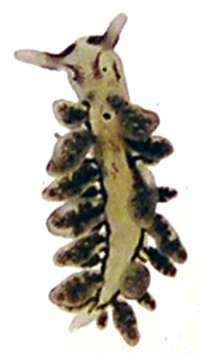
Note added 2 March 2006: Russian animals are now considered to be Hermaea vancouverensis [see message #15995].
Dear Bill,
In reply to your questions [#14612], Stiliger akkeshiensis was listed for Kuril Islands by Minichev (1974) and Martynov (1997) but without anything information. The patches on the head consist of dark-brown pigment in epithelial tissues. According to the original description, preserved specimens of S. akkeshiensis "....have traces blackish mottles and streaks on the head" (Baba, 1935: p. 117).
Locality: Shikotan Island, Russia. Depth: 2-3 m. Length: 3 mm. 17 July, 2005. on algae. Photographer: Alexei Chernyshev
-
Baba K. (1935) The fauna of Akkeshi Bay. I. Opistobranchia. Journal of the Faculty of Science, Hokkaido Imperial University, ser. VI, Zoology, 4(3): 115-125.
-
Martynov A.V. (1997) Subclassis Opisthobranchia. In: Kussakin O.G., Ivanova M.B., Tsurpalo A.P. et al. A check-list of animals, plants and fungi from the intertidal zone of Far Eastern seas of Russia. Vladivostok, Dalnauka: 77-80 (in Russian)
-
Minichev Yu.S. (1974) Orders Sacoglossa Acoela. In: Zhirmunskiy (ed.) Rastitel'nyi I zhivotnyi mir Kurilskikh ostrovov. Novosibirsk, Nauka: 366 (in Russian)
Best wishes,
Alexei
tsher@bio.dvgu.ru
Chernyshev, A.V., 2005 (Sep 9) Re: Stiliger akkeshiensis from Kuril Islands. [Message in] Sea Slug Forum. Australian Museum, Sydney. Available from http://www.seaslugforum.net/find/14728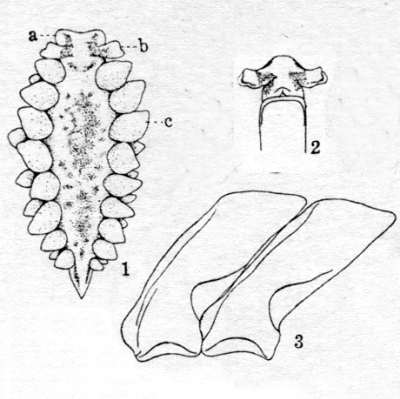
Dear Alexei,
Yes I can see in this photo the head markings are on the skin. I have attached a copy of Baba's original illustrations [Pl. VII, figs 1-3], which shows the radula is very similar, and the head markings could be the same. But as I said earlier, a description of a preserved animal is not a lot to work with.
Best wishes,
Bill Rudman
Stiliger akkeshiensis from Kuril Islands
September 8, 2005
From: Alexei Chernyshev

Note added 2 March 2006: Russian animals are now considered to be Hermaea vancouverensis [see message #15995].
Dear Bill,
Stiliger akkeshiensis Baba, 1935 is a common species near the South Kuril Islands. It lives amongst the red algae Neorhodomela larix, Ptilota sp., Odonthalia sp. etc.
Locality: Shikotan Island, Kuril Islands, Russia, NW Pacific. Depth: 2-3 m. Length: 3-4 mm. 17 July, 2005. on the red algae. Photographer: A.V. Chernyshev
Best regards,
Alexei
tsher@bio.dvgu.ru
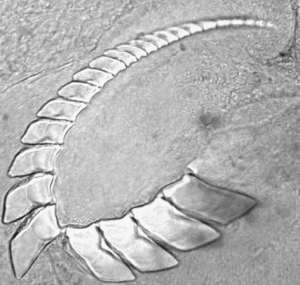
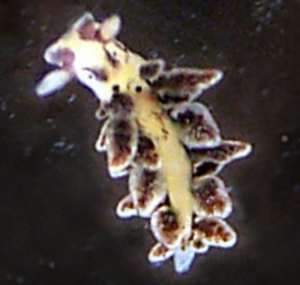
Thanks Alexei,
Another species for the Forum. I have prepared a Fact Sheet. Are there any other references I should add? I agree you identification seems to fit, but it is unfortunate the original description had no information on the living animal. Do you know if the dark lines on the head are digestive gland branches? Perhaps Kathe Jensen can give us her thoughts on whether Stiliger is the best genus for this species
Best wishes,
Bill Rudman
